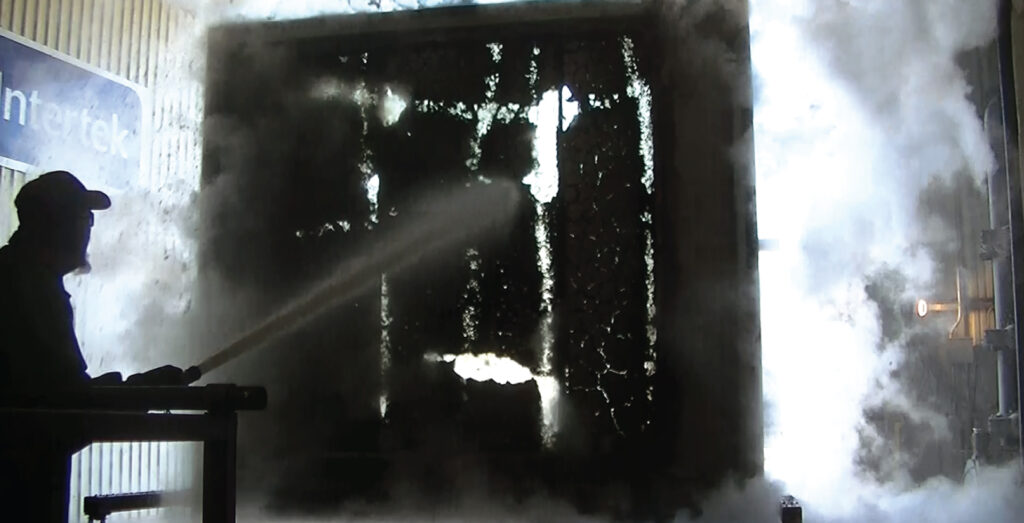Is the Hose Stream Test just a sales strategy or a safety test?

The Hose Stream Test… Safety Test or Sales Strategy?
This article reviews the Hose Stream Test and examines whether it is a safety test or a sales strategy. The original purpose of the hose stream test was to measure the structural integrity of building walls, not to test fire rated glass.
Even though Europe and the United Kingdom abandoned the hose stream test a long time ago, U.S. companies continue to debate its relevancy as a performance measure for fire-rated glass. Confusion over the importance of the test has weakened its credibility as an appropriate safety measure for fire glass leaving some manufacturers believing it’s more useful as a marketing ploy than a product safety test. In speaking with industry members, fire protection specialists and fire officials, there seems to be but one point of agreement – the hose stream test wasn’t designed to measure glazing performance.
The basic hose stream test in the US today involves taking a piece of fire-rated glass out of the test furnace and immediately and evenly hitting it with a hose stream across its surface. If the glass remains intact without exceeding the allowable through openings, it passes the test.
Never Intended to Test Glass
The original purpose of the hose stream test was to measure the structural integrity of building walls and other support components in the event of a fire. The test was originally performed using weights to impact the assembly, not water. The hose stream was adopted because it could be applied easily and evenly over the assembly instead of just hitting at the center.
Those In Favor of the Hose Stream
Proponents of the hose stream test for glazing believe that it’s a valid test for thermal shock resistance, helping to ensure against a glazing’s early failure when used with sprinklers. However, there doesn’t seem to be any material support for this in fire test standards or available historical summaries.
In discussions with fire service officials, one explanation comes up that ties the hose stream to thermal shock, but the connection is to doors, not glazing. Fire fighters’ are concerned about the potential for steel doors to blow out of their openings when hit with water from fire hoses. Due to steel’s expansion during a fire, the pressure on the fire side can blow the door out when it is suddenly cooled by water.
Fire fighters, however, are not concerned about glass failure in vision panels because once they are on the scene with their fire hoses a broken vision panel allows better access to the seat of the fire, at a time when the extended protection provided by fire-rated glass is no longer needed.
Those In Doubt of the Hose Stream
Critics of the hose stream test emphasize that it wasn’t designed as a thermal shock test for glazing exposed to fire sprinklers, and that it isn’t relevant for that purpose because the test is applied after the glazing has been exposed to fire for 45 minutes in a furnace heated to about 1600F degrees. They contend that, in a real fire, rated fire sprinklers activate at low specified temperatures within the first few minutes of a fire, well before the glazing gets hot enough to create thermal stress.
What Happens in the Field to Glazing that Fails the Hose Stream?
Does glass that can’t pass the hose stream test fail in a real fire when exposed to sprinklers? If you ask fire-rated glass manufacturers, they will unequivocally say “no.” And they’ll point to actual case history in the U.S. and Europe where the glass has successfully withstood, time and time again, water exposure from sprinklers activated within the first minutes of the fire.
Some field facts to consider:
- The largest European manufacturer of these products reported to the NFPA that of the millions of square feet of fire-rated glass, up to 60-minutes, installed worldwide since 1983, there hasn’t been a single reported failure.
- Twenty-minute glazing products rated without hose stream have been accepted in 20-minute assemblies in the U.S. since 1992 without any reported failures.
- The NFPA Standards Council, upon finding no evidence of any field problems with glazing that did not pass the hose stream test, rejected the wired glass industry’s code proposal to eliminate the hose stream exemption for 20-minute glazing in 1997.
- Wired glass manufacturers make and sell fire glass products overseas that are tested without hose stream for use in 20, 45 and 60-minute applications, even though they argue that the hose stream test is critical to fire safety.
So, should there be an alternative test option to measure thermal stress?
Proponents of an alternative test option explain that while the hose stream has a place as one test method, it should not be used to reject inexpensive high impact safety glazings, with 45-minute or higher fire protection, that do withstand sprinklers.
So, yes, there appears to be a need for an alternative test option to measure thermal stress resistance to fire sprinklers that gives assurance against failure, one that measures thermal stress resistance under simulated fire conditions, but doesn’t arbitrarily exclude fire rated glazings that also offer high impact protection.
Does it serve any fire safety purpose to require fire-rated glazing to meet the hose stream in non-sprinklered buildings?
And Finally …
After safety and fire performance are considered, cost is an important benefit of rated glazings that perform successfully without hose stream. For example, there’s about a 300% difference in price between a 45-minute Cat. II 5/16” ceramic glazing tested with hose stream made in Japan, and a 45-minute 1/4” alternative tested without hose stream made in the U.S.
Considering the cost and the lack of evidence of field failure, the hose stream starts to look more like a dubious sales strategy for selling fire-rated glass than a legitimate fire safety test for measuring its true performance.